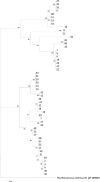Matrix-assisted laser desorption ionization (MALDI)-time of flight mass spectrometry- and MALDI biotyper-based identification of cultured biphenyl-metabolizing bacteria from contaminated horseradish rhizosphere soil
- PMID: 21821747
- PMCID: PMC3187117
- DOI: 10.1128/AEM.05465-11
Matrix-assisted laser desorption ionization (MALDI)-time of flight mass spectrometry- and MALDI biotyper-based identification of cultured biphenyl-metabolizing bacteria from contaminated horseradish rhizosphere soil
Abstract
Bacteria that are able to utilize biphenyl as a sole source of carbon were extracted and isolated from polychlorinated biphenyl (PCB)-contaminated soil vegetated by horseradish. Isolates were identified using matrix-assisted laser desorption ionization-time of flight mass spectrometry (MALDI-TOF MS). The usage of MALDI Biotyper for the classification of isolates was evaluated and compared to 16S rRNA gene sequence analysis. A wide spectrum of bacteria was isolated, with Arthrobacter, Serratia, Rhodococcus, and Rhizobium being predominant. Arthrobacter isolates also represented the most diverse group. The use of MALDI Biotyper in many cases permitted the identification at the level of species, which was not achieved by 16S rRNA gene sequence analyses. However, some isolates had to be identified by 16S rRNA gene analyses if MALDI Biotyper-based identification was at the level of probable or not reliable identification, usually due to a lack of reference spectra included in the database. Overall, this study shows the possibility of using MALDI-TOF MS and MALDI Biotyper for the fast and relatively nonlaborious identification/classification of soil isolates. At the same time, it demonstrates the dominant role of employing 16S rRNA gene analyses for the identification of recently isolated strains that can later fill the gaps in the protein-based identification databases.
Figures



Similar articles
-
Species identification of clinical isolates of Bacteroides by matrix-assisted laser-desorption/ionization time-of-flight mass spectrometry.Clin Microbiol Infect. 2009 Aug;15(8):796-802. doi: 10.1111/j.1469-0691.2009.02788.x. Epub 2009 May 11. Clin Microbiol Infect. 2009. PMID: 19438622
-
Identification of environmental Actinobacteria in buildings by means of chemotaxonomy, 16S rRNA sequencing, and MALDI-TOF MS.Microbiol Spectr. 2024 Mar 5;12(3):e0359623. doi: 10.1128/spectrum.03596-23. Epub 2024 Feb 1. Microbiol Spectr. 2024. PMID: 38299830 Free PMC article.
-
Evaluation of matrix-assisted laser desorption ionization-time-of-flight mass spectrometry in comparison to 16S rRNA gene sequencing for species identification of nonfermenting bacteria.J Clin Microbiol. 2008 Jun;46(6):1946-54. doi: 10.1128/JCM.00157-08. Epub 2008 Apr 9. J Clin Microbiol. 2008. PMID: 18400920 Free PMC article.
-
Rapid and robust MALDI-TOF MS techniques for microbial identification: a brief overview of their diverse applications.J Microbiol. 2018 Apr;56(4):209-216. doi: 10.1007/s12275-018-7457-0. Epub 2018 Feb 28. J Microbiol. 2018. PMID: 29492868 Review.
-
Bacterial Sub-Species Typing Using Matrix-Assisted Laser Desorption/Ionization Time of Flight Mass Spectrometry: What Is Promising?Curr Issues Mol Biol. 2021 Jul 20;43(2):749-757. doi: 10.3390/cimb43020054. Curr Issues Mol Biol. 2021. PMID: 34294671 Free PMC article. Review.
Cited by
-
Cowpea (Vigna unguiculata L. Walp) hosts several widespread bradyrhizobial root nodule symbionts across contrasting agro-ecological production areas in Kenya.Agric Ecosyst Environ. 2018 Jul 1;261:161-171. doi: 10.1016/j.agee.2017.12.014. Agric Ecosyst Environ. 2018. PMID: 29970945 Free PMC article.
-
Evaluation of MALDI-TOF mass spectrometry and MALDI BioTyper in comparison to 16S rDNA sequencing for the identification of bacteria isolated from Arctic sea water.PLoS One. 2017 Jul 24;12(7):e0181860. doi: 10.1371/journal.pone.0181860. eCollection 2017. PLoS One. 2017. PMID: 28738078 Free PMC article.
-
MALDI-TOF MS Affords Discrimination of Deinococcus aquaticus Isolates Obtained From Diverse Biofilm Habitats.Front Microbiol. 2018 Oct 15;9:2442. doi: 10.3389/fmicb.2018.02442. eCollection 2018. Front Microbiol. 2018. PMID: 30374340 Free PMC article.
-
A designed experiments approach to optimization of automated data acquisition during characterization of bacteria with MALDI-TOF mass spectrometry.PLoS One. 2014 Mar 24;9(3):e92720. doi: 10.1371/journal.pone.0092720. eCollection 2014. PLoS One. 2014. PMID: 24662978 Free PMC article.
-
Bacteria Associated to Plants Naturally Selected in a Historical PCB Polluted Soil Show Potential to Sustain Natural Attenuation.Front Microbiol. 2017 Jul 25;8:1385. doi: 10.3389/fmicb.2017.01385. eCollection 2017. Front Microbiol. 2017. PMID: 28790991 Free PMC article.
References
-
- Abraham W. R., Wenderoth D. F., Glasser W. 2005. Diversity of biphenyl degraders in a chlorobenzene polluted aquifer. Chemosphere 58:529–533 - PubMed
-
- Alispahic M., et al. 2010. Species-specific identification and differentiation of Arcobacter, Helicobacter and Campylobacter by full-spectral matrix-associated laser desorption/ionization time of flight mass spectrometry analysis. J. Med. Microbiol. 59:295–301 - PubMed
-
- Arnold R. J., Reilly J. P. 1998. Fingerprint matching of E. coli strains with matrix-assisted laser desorption/ionization time-of-flight mass spectrometry of whole cells using a modified correlation approach. Rapid Commun. Mass Spectrom. 12:630–636 - PubMed
-
- Asturias J. A., Diaz E., Timmis K. N. 1995. The evolutionary relationship of biphenyl dioxygenase from gram-positive Rhodococcus globerulus P6 to multicomponent dioxygenases from gram-negative bacteria. Gene 156:11–18 - PubMed
Publication types
MeSH terms
Substances
Associated data
- Actions
- Actions
- Actions
- Actions
- Actions
- Actions
- Actions
- Actions
- Actions
- Actions
- Actions
- Actions
- Actions
- Actions
- Actions
- Actions
- Actions
- Actions
- Actions
- Actions
- Actions
- Actions
- Actions
- Actions
- Actions
- Actions
- Actions
- Actions
- Actions
- Actions
- Actions
- Actions
- Actions
- Actions
- Actions
- Actions
- Actions
- Actions
- Actions
- Actions
- Actions
- Actions
- Actions
- Actions
- Actions
- Actions
- Actions
- Actions
- Actions
- Actions
- Actions
- Actions
- Actions
- Actions
LinkOut - more resources
Full Text Sources
Molecular Biology Databases

